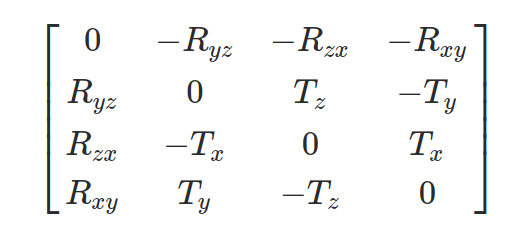so last weekend @raphlinus told me about using geometric algebra instead of homogeneous/projection space matrices to do geometry (siggraph talk linked)
and i had some Physicist Thoughts https://www.youtube.com/watch?v=tX4H_ctggYo">https://www.youtube.com/watch...
and i had some Physicist Thoughts https://www.youtube.com/watch?v=tX4H_ctggYo">https://www.youtube.com/watch...
warning, most of this thread is just me thinking out loud, it might not make much sense
anyway, part of this specific geometric algebra is that it ends up representing translations and rotations as bivectors, where the symmetric ones are translations, and the antisymmetric ones are rotations
And he mentioned that in higher dimensions rotations end up getting more components and aren& #39;t as straightforward, because they& #39;re the remaining components of the bivector
it essentially "works out" in 3 dimensions because 3C2 == 3C3
it essentially "works out" in 3 dimensions because 3C2 == 3C3
this made me think "where have i seen this before -- oh right, relativity and Maxwell& #39;s equations!"
See, you can represent the electromagnetic field as a single tensor, in 3+1-dimensional space (the +1 is time).
The electric field is in the time component, and the magnetic field is in the antisymmetric bits of the space component
The electric field is in the time component, and the magnetic field is in the antisymmetric bits of the space component
you can take an appropriately indexed covariant derivative of this and get Maxwell& #39;s first two equations (putting the four-current on the other side)
you can also take its Hodge dual (in 3+1D basically has its E and B components swapped), take the covariant derivative of *that*, set it to zero, and get Maxwell& #39;s other two equations
overall the tensor representation has lots of useful properties & also works with relativity
overall the tensor representation has lots of useful properties & also works with relativity
in n dimensions, you get n electric field components, but nC2 magnetic field components -- as a true bivector it doesn& #39;t generalize the same way
this seems *very* familiar. n+1 dimensions, where one is the special non-spatial dimension. you can mix a bivector and a vector multiplied by the additional dimension to get a useful space.
all this made me wonder: is there any possible intuition or modelling crossover possible?
googling "projective geometry special relativity" yields some research on the transfer of ideas from projective geometry to relativity
googling "projective geometry special relativity" yields some research on the transfer of ideas from projective geometry to relativity
this makes sense, physicists try out all kinds of algebrae for modelling things
the reverse is more interesting. does doing an operation similar to the Hodge dual -- where rotation and translation components get swapped -- lead to a space with any meaningful intuition?
the reverse is more interesting. does doing an operation similar to the Hodge dual -- where rotation and translation components get swapped -- lead to a space with any meaningful intuition?

 Read on Twitter
Read on Twitter



